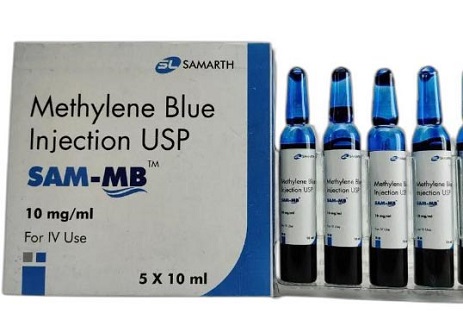Nikhil Prasad Fact checked by:Thailand Medical News Team Sep 03, 2024 1 year, 3 months, 3 weeks, 3 days, 7 hours, 10 minutes ago
Glaucoma News: Glaucoma is one of the leading causes of blindness globally, affecting millions of people. Despite various treatments, many patients continue to suffer from vision loss. The focus of most current treatments is on reducing intraocular pressure (IOP), but this does not always prevent the progression of the disease. A recent study, conducted by researchers from the University of Buenos Aires in Argentina and the Center for Biomedical Research of La Rioja (CIBIR) in Spain, offers new hope. This
Glaucoma News report explores their findings, which suggest that methylene blue (MB) could play a crucial role in protecting vision by preventing the death of retinal ganglion cells (RGCs), the cells most affected by glaucoma.
 Methylene blue shows promise in preventing vision loss in Glaucoma patients
Understanding Glaucoma and the Need for New Treatments
Methylene blue shows promise in preventing vision loss in Glaucoma patients
Understanding Glaucoma and the Need for New Treatments
Glaucoma is a group of eye conditions that damage the optic nerve, essential for good vision. This damage is often caused by abnormally high pressure in the eye, although glaucoma can occur even with normal IOP. The disease progresses silently, often without symptoms until significant vision loss has occurred. Primary open-angle glaucoma (POAG) is the most common type, accounting for more than 80% of cases. Current treatments focus on reducing IOP through medications or surgery. However, these approaches do not address the neurodegenerative process that leads to the death of RGCs, which is the primary cause of vision loss in glaucoma patients.
The Role of Methylene Blue in Neuroprotection
Methylene blue is a compound with a long history of medical use, primarily known for treating methemoglobinemia, a condition where blood cannot deliver oxygen effectively. It has a high safety profile and is on the World Health Organization's List of Essential Medicines. The researchers in this study explored whether MB could protect RGCs from the damage caused by high IOP, using a rat model of glaucoma. The study highlights the potential of MB as a neuroprotective agent that could prevent or slow down the progression of glaucoma.
Study Design and Methodology
The research team used a well-established rat model of glaucoma, where the episcleral veins of one eye were cauterized to induce high IOP, simulating the conditions of human POAG. The rats were then divided into two groups: one received daily injections of MB, and the other received a saline solution as a control. After 15 days, the researchers performed electroretinography (ERG) and histological analyses to assess the impact of MB on retinal health.
Key Findings: Methylene Blue Preserves Retinal Function
The study's results were promising. Rats treated with MB showed significant preservation of both the a- and b-wave amplitudes in scotopic ERG, indicating that the electrical activity of the retina, particularly in the photoreceptors and inner retinal cells, was maintained despite elevated IOP. This preservation suggests that MB can protect the retina's function, a key finding that
could have significant implications for glaucoma treatment.
Moreover, the study found that MB treatment preserved the complexity of oscillatory potentials (OPs) in the ERG. OPs are sensitive indicators of retinal vascular health, and their preservation suggests that MB could protect against the vascular dysfunction associated with glaucoma.
Detailed Insights into Pattern Electroretinography Findings
Pattern electroretinography (PERG) was used to evaluate the function of RGCs, the cells most vulnerable in glaucoma. The results were striking: rats treated with MB had a significant preservation of the N2 wave amplitude, a critical measure of RGC function. Although MB did not completely restore the implicit time of the N2 wave (a measure of the speed of the retinal response), its ability to maintain RGC function highlights its potential as a neuroprotective agent.
Histological Evidence Supports Neuroprotective Effects
Histological analysis provided further evidence of MB's protective effects. Rats treated with MB had significantly more RGCs and thicker inner retinas compared to the control group. These findings are crucial because they confirm that MB not only preserves the function of retinal cells but also prevents their structural damage.
Potential Mechanisms: How Methylene Blue Works
The neuroprotective effects of MB are thought to be related to its ability to inhibit the enzyme guanylyl cyclase, which is involved in the production of nitric oxide (NO), a molecule that can cause cellular damage in high concentrations. By reducing NO levels, MB may prevent the oxidative stress and cellular damage that contribute to RGC death in glaucoma.
Future Directions: Towards Human Trials
While the results of this study are promising, the research was conducted in a rat model, and further studies are needed to determine whether MB will be effective in humans. However, the high safety profile of MB and its ability to cross the blood-ocular barrier make it a strong candidate for further investigation. Researchers are also exploring ways to improve the delivery of MB to the eye, potentially through topical applications, which could make it easier to use as a long-term treatment for glaucoma.
Conclusions: A New Chapter in Glaucoma Treatment
This study provides compelling evidence that methylene blue could become a valuable tool in the fight against glaucoma. By preserving the function and structure of retinal cells, MB offers a potential new approach to preventing vision loss in patients with glaucoma. However, more research is needed to confirm these findings in humans and to develop practical methods for delivering MB as part of routine glaucoma care.
The study findings were published in the peer-reviewed journal: Biomedicines.
https://www.mdpi.com/2227-9059/12/9/1983
For the
Glaucoma News, keep on logging to Thailand Medical News.
Read Also:
https://www.thailandmedical.news/news/neuroglobin-a-new-hope-for-glaucoma-treatment
https://www.thailandmedical.news/news/16-percent-of-individuals-with-arterial-stiffness-will-develop-glaucoma
